Identification and Analysis of Ethical Issues in Healthcare Case Study
VerifiedAdded on 2021/06/16
|8
|2156
|18
Report
AI Summary
This report analyzes a healthcare case study involving a cholera outbreak, focusing on the ethical issues surrounding patient care and resource allocation. The case highlights violations of patient rights, including discrimination and lack of continuity of care, as well as deficiencies in hospital preparedness and adherence to ethical codes. The analysis examines the hospital's decision-making process, the conflict between limited resources and patient needs, and the impact on the patient, Amos. The report identifies key ethical principles such as autonomy, beneficence, and non-maleficence, and provides recommendations for improved professional practice. These include implementing risk management strategies, ensuring adequate medical supplies, developing emergency backup plans, and fostering communication between hospital staff and management. The report emphasizes the importance of ethical decision-making in healthcare to prevent future occurrences of similar ethical dilemmas.
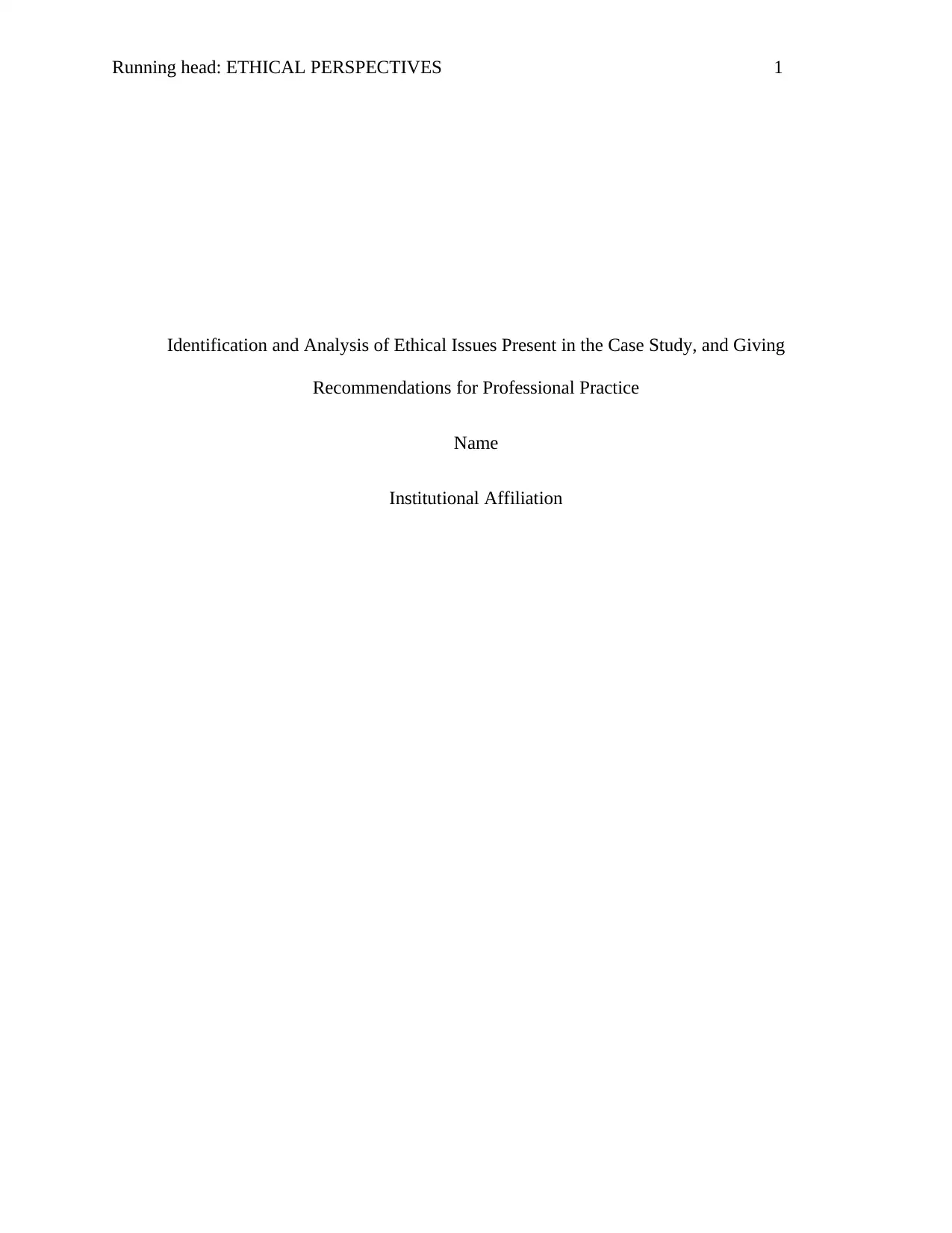
Running head: ETHICAL PERSPECTIVES 1
Identification and Analysis of Ethical Issues Present in the Case Study, and Giving
Recommendations for Professional Practice
Name
Institutional Affiliation
Identification and Analysis of Ethical Issues Present in the Case Study, and Giving
Recommendations for Professional Practice
Name
Institutional Affiliation
Paraphrase This Document
Need a fresh take? Get an instant paraphrase of this document with our AI Paraphraser
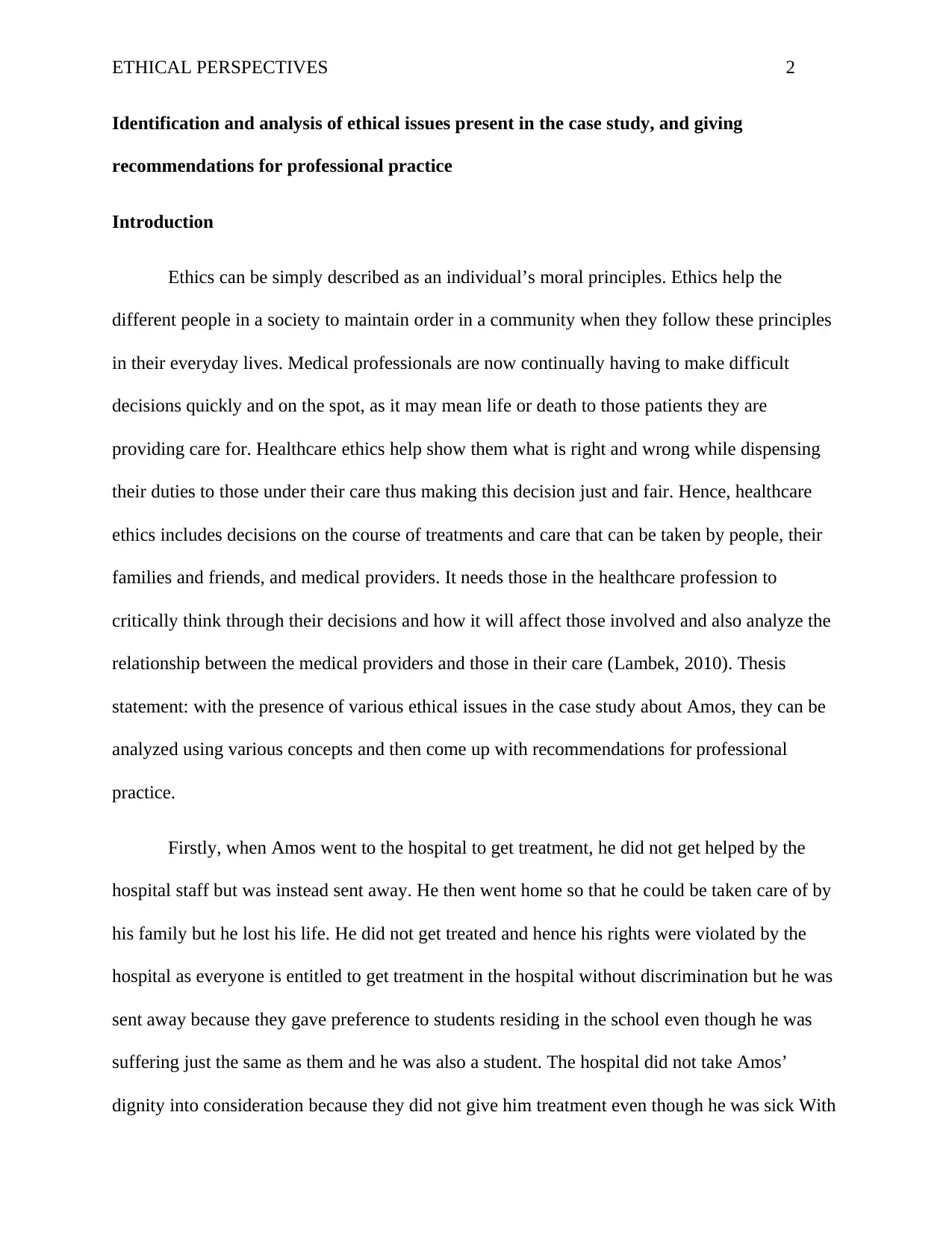
ETHICAL PERSPECTIVES 2
Identification and analysis of ethical issues present in the case study, and giving
recommendations for professional practice
Introduction
Ethics can be simply described as an individual’s moral principles. Ethics help the
different people in a society to maintain order in a community when they follow these principles
in their everyday lives. Medical professionals are now continually having to make difficult
decisions quickly and on the spot, as it may mean life or death to those patients they are
providing care for. Healthcare ethics help show them what is right and wrong while dispensing
their duties to those under their care thus making this decision just and fair. Hence, healthcare
ethics includes decisions on the course of treatments and care that can be taken by people, their
families and friends, and medical providers. It needs those in the healthcare profession to
critically think through their decisions and how it will affect those involved and also analyze the
relationship between the medical providers and those in their care (Lambek, 2010). Thesis
statement: with the presence of various ethical issues in the case study about Amos, they can be
analyzed using various concepts and then come up with recommendations for professional
practice.
Firstly, when Amos went to the hospital to get treatment, he did not get helped by the
hospital staff but was instead sent away. He then went home so that he could be taken care of by
his family but he lost his life. He did not get treated and hence his rights were violated by the
hospital as everyone is entitled to get treatment in the hospital without discrimination but he was
sent away because they gave preference to students residing in the school even though he was
suffering just the same as them and he was also a student. The hospital did not take Amos’
dignity into consideration because they did not give him treatment even though he was sick With
Identification and analysis of ethical issues present in the case study, and giving
recommendations for professional practice
Introduction
Ethics can be simply described as an individual’s moral principles. Ethics help the
different people in a society to maintain order in a community when they follow these principles
in their everyday lives. Medical professionals are now continually having to make difficult
decisions quickly and on the spot, as it may mean life or death to those patients they are
providing care for. Healthcare ethics help show them what is right and wrong while dispensing
their duties to those under their care thus making this decision just and fair. Hence, healthcare
ethics includes decisions on the course of treatments and care that can be taken by people, their
families and friends, and medical providers. It needs those in the healthcare profession to
critically think through their decisions and how it will affect those involved and also analyze the
relationship between the medical providers and those in their care (Lambek, 2010). Thesis
statement: with the presence of various ethical issues in the case study about Amos, they can be
analyzed using various concepts and then come up with recommendations for professional
practice.
Firstly, when Amos went to the hospital to get treatment, he did not get helped by the
hospital staff but was instead sent away. He then went home so that he could be taken care of by
his family but he lost his life. He did not get treated and hence his rights were violated by the
hospital as everyone is entitled to get treatment in the hospital without discrimination but he was
sent away because they gave preference to students residing in the school even though he was
suffering just the same as them and he was also a student. The hospital did not take Amos’
dignity into consideration because they did not give him treatment even though he was sick With
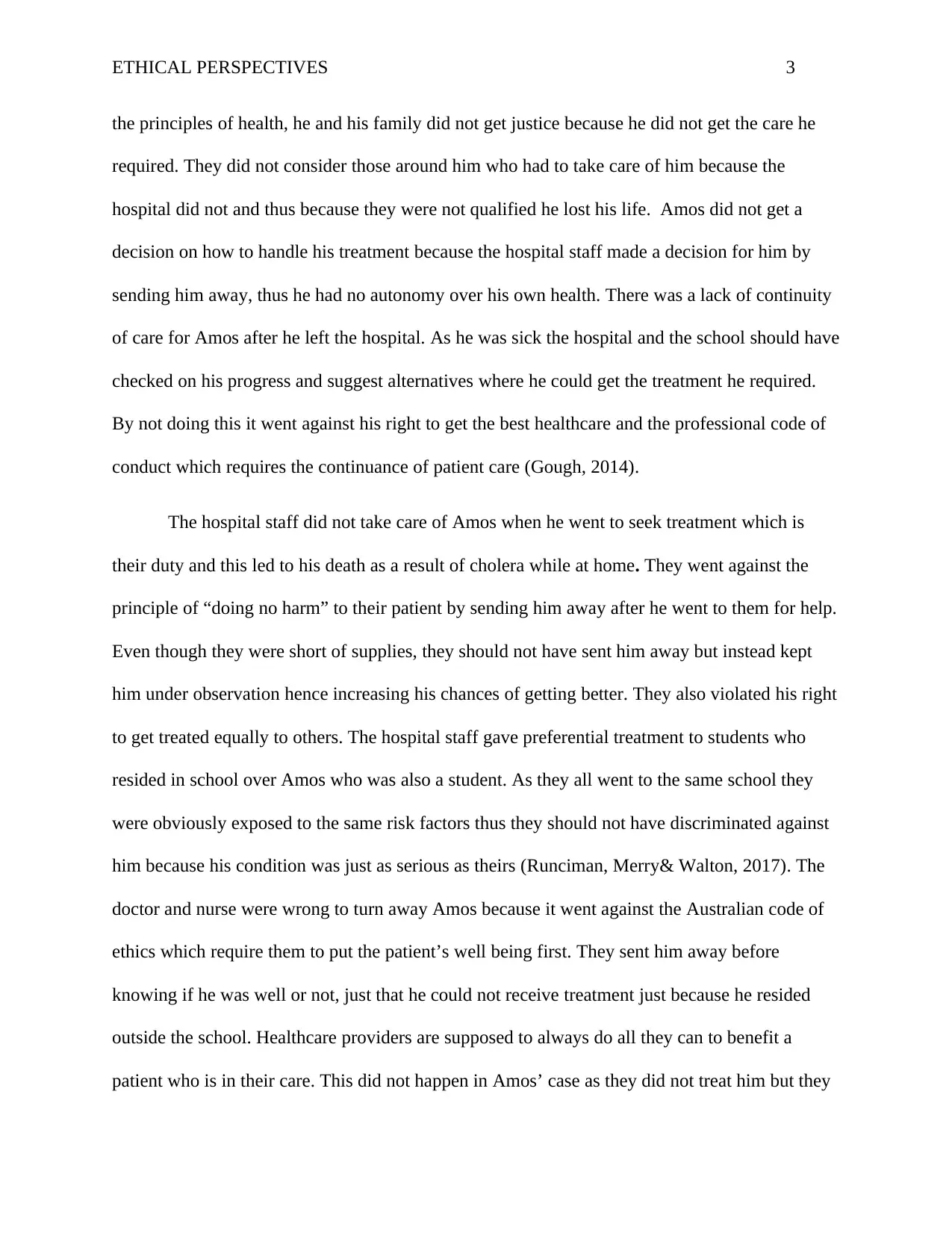
ETHICAL PERSPECTIVES 3
the principles of health, he and his family did not get justice because he did not get the care he
required. They did not consider those around him who had to take care of him because the
hospital did not and thus because they were not qualified he lost his life. Amos did not get a
decision on how to handle his treatment because the hospital staff made a decision for him by
sending him away, thus he had no autonomy over his own health. There was a lack of continuity
of care for Amos after he left the hospital. As he was sick the hospital and the school should have
checked on his progress and suggest alternatives where he could get the treatment he required.
By not doing this it went against his right to get the best healthcare and the professional code of
conduct which requires the continuance of patient care (Gough, 2014).
The hospital staff did not take care of Amos when he went to seek treatment which is
their duty and this led to his death as a result of cholera while at home. They went against the
principle of “doing no harm” to their patient by sending him away after he went to them for help.
Even though they were short of supplies, they should not have sent him away but instead kept
him under observation hence increasing his chances of getting better. They also violated his right
to get treated equally to others. The hospital staff gave preferential treatment to students who
resided in school over Amos who was also a student. As they all went to the same school they
were obviously exposed to the same risk factors thus they should not have discriminated against
him because his condition was just as serious as theirs (Runciman, Merry& Walton, 2017). The
doctor and nurse were wrong to turn away Amos because it went against the Australian code of
ethics which require them to put the patient’s well being first. They sent him away before
knowing if he was well or not, just that he could not receive treatment just because he resided
outside the school. Healthcare providers are supposed to always do all they can to benefit a
patient who is in their care. This did not happen in Amos’ case as they did not treat him but they
the principles of health, he and his family did not get justice because he did not get the care he
required. They did not consider those around him who had to take care of him because the
hospital did not and thus because they were not qualified he lost his life. Amos did not get a
decision on how to handle his treatment because the hospital staff made a decision for him by
sending him away, thus he had no autonomy over his own health. There was a lack of continuity
of care for Amos after he left the hospital. As he was sick the hospital and the school should have
checked on his progress and suggest alternatives where he could get the treatment he required.
By not doing this it went against his right to get the best healthcare and the professional code of
conduct which requires the continuance of patient care (Gough, 2014).
The hospital staff did not take care of Amos when he went to seek treatment which is
their duty and this led to his death as a result of cholera while at home. They went against the
principle of “doing no harm” to their patient by sending him away after he went to them for help.
Even though they were short of supplies, they should not have sent him away but instead kept
him under observation hence increasing his chances of getting better. They also violated his right
to get treated equally to others. The hospital staff gave preferential treatment to students who
resided in school over Amos who was also a student. As they all went to the same school they
were obviously exposed to the same risk factors thus they should not have discriminated against
him because his condition was just as serious as theirs (Runciman, Merry& Walton, 2017). The
doctor and nurse were wrong to turn away Amos because it went against the Australian code of
ethics which require them to put the patient’s well being first. They sent him away before
knowing if he was well or not, just that he could not receive treatment just because he resided
outside the school. Healthcare providers are supposed to always do all they can to benefit a
patient who is in their care. This did not happen in Amos’ case as they did not treat him but they
⊘ This is a preview!⊘
Do you want full access?
Subscribe today to unlock all pages.

Trusted by 1+ million students worldwide
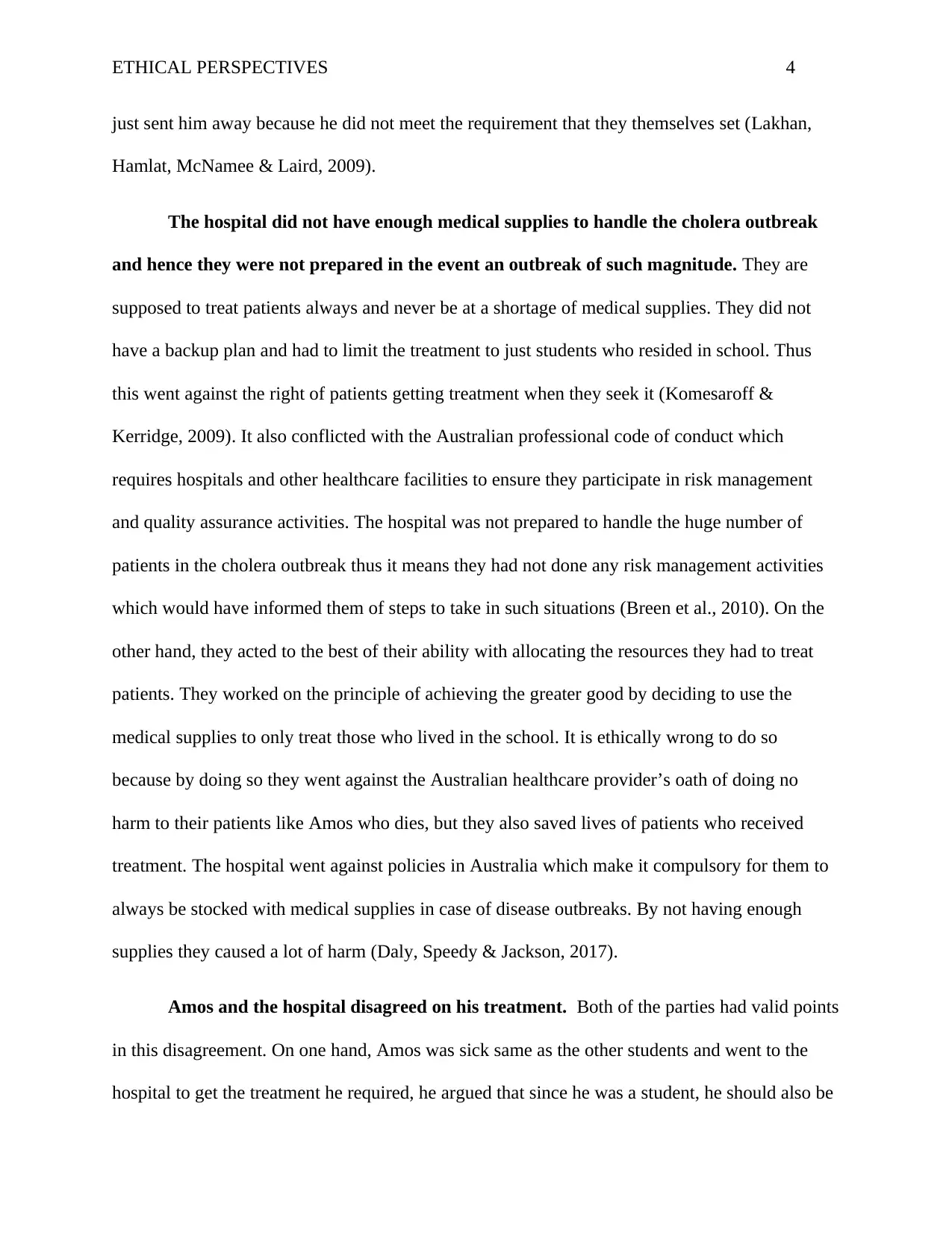
ETHICAL PERSPECTIVES 4
just sent him away because he did not meet the requirement that they themselves set (Lakhan,
Hamlat, McNamee & Laird, 2009).
The hospital did not have enough medical supplies to handle the cholera outbreak
and hence they were not prepared in the event an outbreak of such magnitude. They are
supposed to treat patients always and never be at a shortage of medical supplies. They did not
have a backup plan and had to limit the treatment to just students who resided in school. Thus
this went against the right of patients getting treatment when they seek it (Komesaroff &
Kerridge, 2009). It also conflicted with the Australian professional code of conduct which
requires hospitals and other healthcare facilities to ensure they participate in risk management
and quality assurance activities. The hospital was not prepared to handle the huge number of
patients in the cholera outbreak thus it means they had not done any risk management activities
which would have informed them of steps to take in such situations (Breen et al., 2010). On the
other hand, they acted to the best of their ability with allocating the resources they had to treat
patients. They worked on the principle of achieving the greater good by deciding to use the
medical supplies to only treat those who lived in the school. It is ethically wrong to do so
because by doing so they went against the Australian healthcare provider’s oath of doing no
harm to their patients like Amos who dies, but they also saved lives of patients who received
treatment. The hospital went against policies in Australia which make it compulsory for them to
always be stocked with medical supplies in case of disease outbreaks. By not having enough
supplies they caused a lot of harm (Daly, Speedy & Jackson, 2017).
Amos and the hospital disagreed on his treatment. Both of the parties had valid points
in this disagreement. On one hand, Amos was sick same as the other students and went to the
hospital to get the treatment he required, he argued that since he was a student, he should also be
just sent him away because he did not meet the requirement that they themselves set (Lakhan,
Hamlat, McNamee & Laird, 2009).
The hospital did not have enough medical supplies to handle the cholera outbreak
and hence they were not prepared in the event an outbreak of such magnitude. They are
supposed to treat patients always and never be at a shortage of medical supplies. They did not
have a backup plan and had to limit the treatment to just students who resided in school. Thus
this went against the right of patients getting treatment when they seek it (Komesaroff &
Kerridge, 2009). It also conflicted with the Australian professional code of conduct which
requires hospitals and other healthcare facilities to ensure they participate in risk management
and quality assurance activities. The hospital was not prepared to handle the huge number of
patients in the cholera outbreak thus it means they had not done any risk management activities
which would have informed them of steps to take in such situations (Breen et al., 2010). On the
other hand, they acted to the best of their ability with allocating the resources they had to treat
patients. They worked on the principle of achieving the greater good by deciding to use the
medical supplies to only treat those who lived in the school. It is ethically wrong to do so
because by doing so they went against the Australian healthcare provider’s oath of doing no
harm to their patients like Amos who dies, but they also saved lives of patients who received
treatment. The hospital went against policies in Australia which make it compulsory for them to
always be stocked with medical supplies in case of disease outbreaks. By not having enough
supplies they caused a lot of harm (Daly, Speedy & Jackson, 2017).
Amos and the hospital disagreed on his treatment. Both of the parties had valid points
in this disagreement. On one hand, Amos was sick same as the other students and went to the
hospital to get the treatment he required, he argued that since he was a student, he should also be
Paraphrase This Document
Need a fresh take? Get an instant paraphrase of this document with our AI Paraphraser
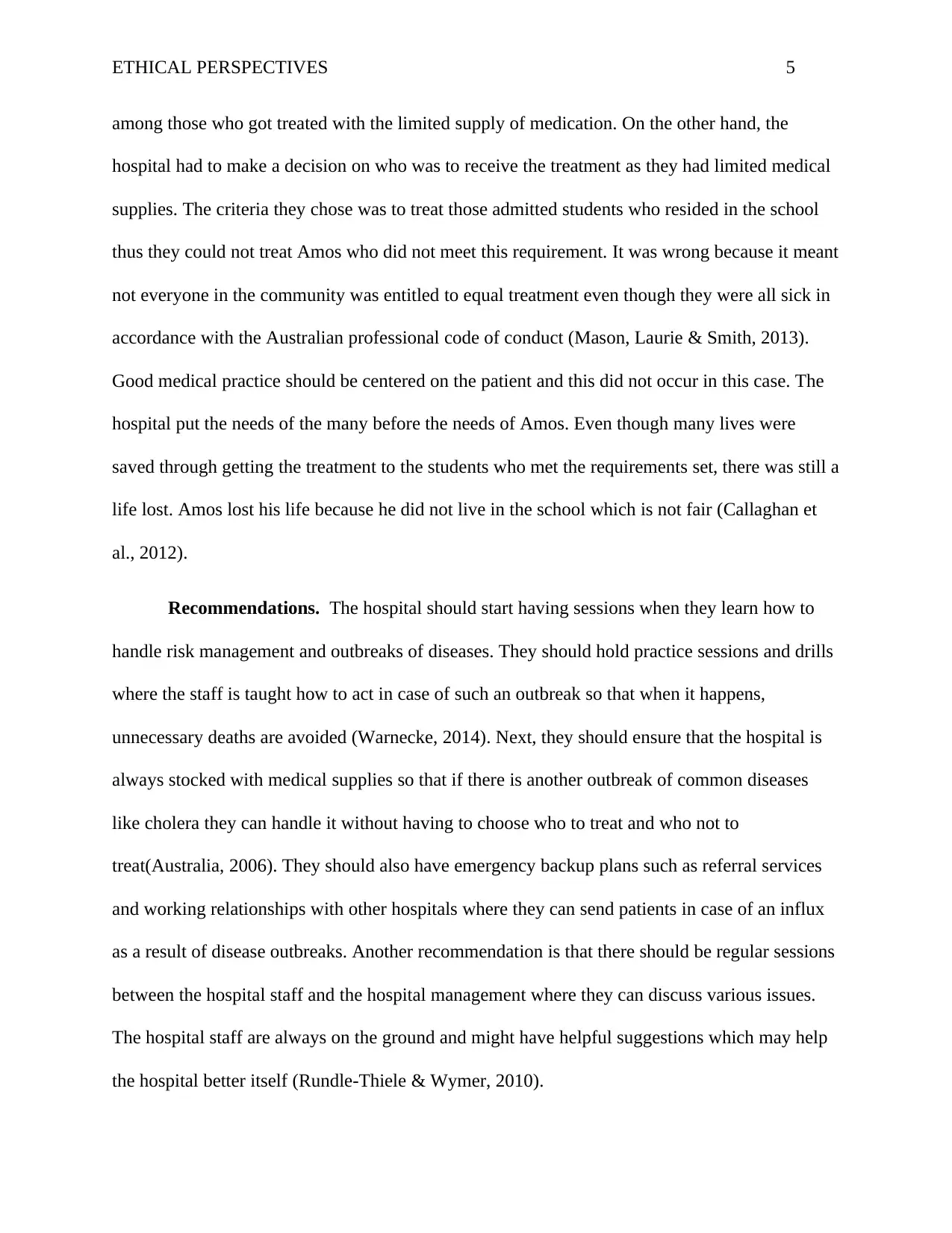
ETHICAL PERSPECTIVES 5
among those who got treated with the limited supply of medication. On the other hand, the
hospital had to make a decision on who was to receive the treatment as they had limited medical
supplies. The criteria they chose was to treat those admitted students who resided in the school
thus they could not treat Amos who did not meet this requirement. It was wrong because it meant
not everyone in the community was entitled to equal treatment even though they were all sick in
accordance with the Australian professional code of conduct (Mason, Laurie & Smith, 2013).
Good medical practice should be centered on the patient and this did not occur in this case. The
hospital put the needs of the many before the needs of Amos. Even though many lives were
saved through getting the treatment to the students who met the requirements set, there was still a
life lost. Amos lost his life because he did not live in the school which is not fair (Callaghan et
al., 2012).
Recommendations. The hospital should start having sessions when they learn how to
handle risk management and outbreaks of diseases. They should hold practice sessions and drills
where the staff is taught how to act in case of such an outbreak so that when it happens,
unnecessary deaths are avoided (Warnecke, 2014). Next, they should ensure that the hospital is
always stocked with medical supplies so that if there is another outbreak of common diseases
like cholera they can handle it without having to choose who to treat and who not to
treat(Australia, 2006). They should also have emergency backup plans such as referral services
and working relationships with other hospitals where they can send patients in case of an influx
as a result of disease outbreaks. Another recommendation is that there should be regular sessions
between the hospital staff and the hospital management where they can discuss various issues.
The hospital staff are always on the ground and might have helpful suggestions which may help
the hospital better itself (Rundle-Thiele & Wymer, 2010).
among those who got treated with the limited supply of medication. On the other hand, the
hospital had to make a decision on who was to receive the treatment as they had limited medical
supplies. The criteria they chose was to treat those admitted students who resided in the school
thus they could not treat Amos who did not meet this requirement. It was wrong because it meant
not everyone in the community was entitled to equal treatment even though they were all sick in
accordance with the Australian professional code of conduct (Mason, Laurie & Smith, 2013).
Good medical practice should be centered on the patient and this did not occur in this case. The
hospital put the needs of the many before the needs of Amos. Even though many lives were
saved through getting the treatment to the students who met the requirements set, there was still a
life lost. Amos lost his life because he did not live in the school which is not fair (Callaghan et
al., 2012).
Recommendations. The hospital should start having sessions when they learn how to
handle risk management and outbreaks of diseases. They should hold practice sessions and drills
where the staff is taught how to act in case of such an outbreak so that when it happens,
unnecessary deaths are avoided (Warnecke, 2014). Next, they should ensure that the hospital is
always stocked with medical supplies so that if there is another outbreak of common diseases
like cholera they can handle it without having to choose who to treat and who not to
treat(Australia, 2006). They should also have emergency backup plans such as referral services
and working relationships with other hospitals where they can send patients in case of an influx
as a result of disease outbreaks. Another recommendation is that there should be regular sessions
between the hospital staff and the hospital management where they can discuss various issues.
The hospital staff are always on the ground and might have helpful suggestions which may help
the hospital better itself (Rundle-Thiele & Wymer, 2010).
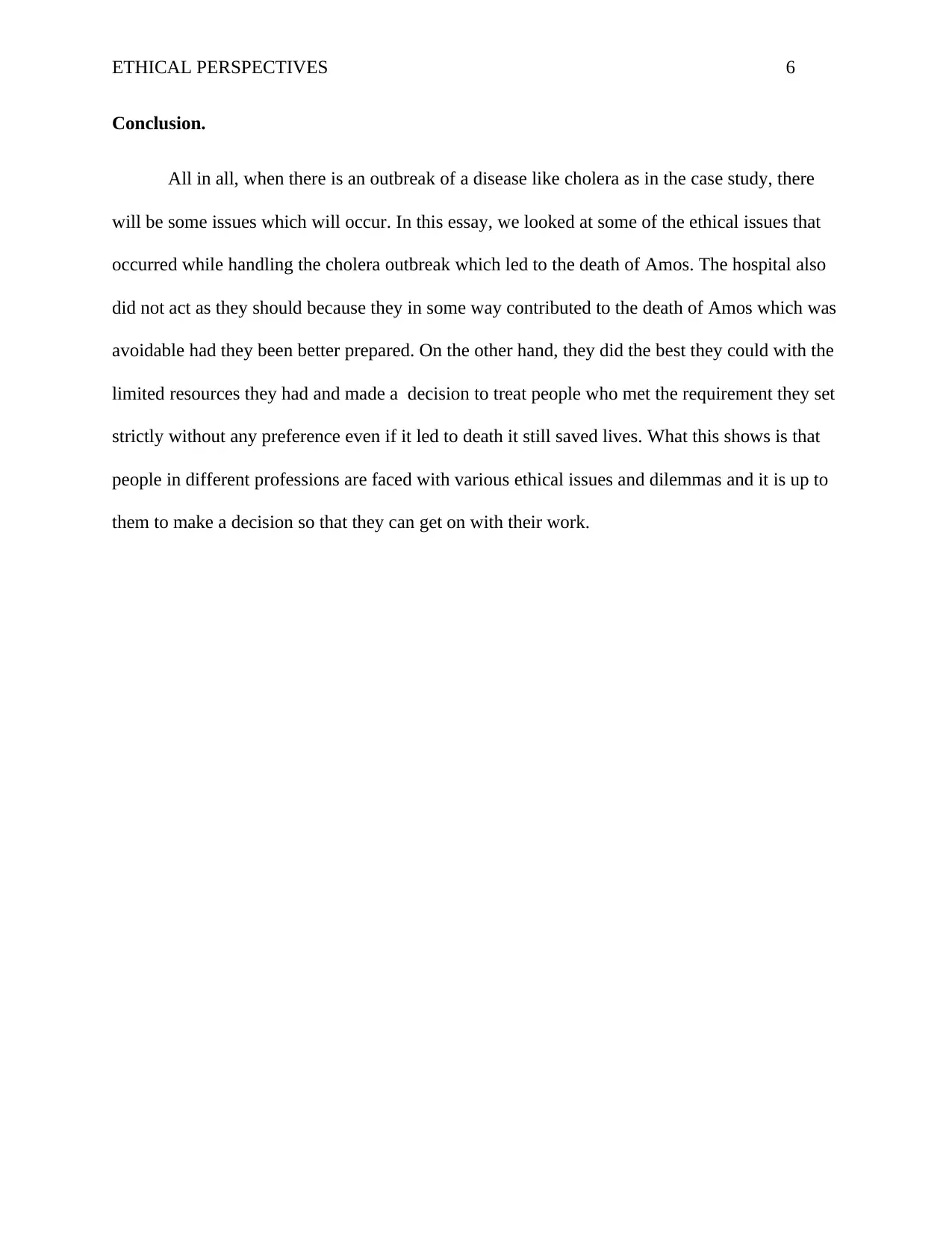
ETHICAL PERSPECTIVES 6
Conclusion.
All in all, when there is an outbreak of a disease like cholera as in the case study, there
will be some issues which will occur. In this essay, we looked at some of the ethical issues that
occurred while handling the cholera outbreak which led to the death of Amos. The hospital also
did not act as they should because they in some way contributed to the death of Amos which was
avoidable had they been better prepared. On the other hand, they did the best they could with the
limited resources they had and made a decision to treat people who met the requirement they set
strictly without any preference even if it led to death it still saved lives. What this shows is that
people in different professions are faced with various ethical issues and dilemmas and it is up to
them to make a decision so that they can get on with their work.
Conclusion.
All in all, when there is an outbreak of a disease like cholera as in the case study, there
will be some issues which will occur. In this essay, we looked at some of the ethical issues that
occurred while handling the cholera outbreak which led to the death of Amos. The hospital also
did not act as they should because they in some way contributed to the death of Amos which was
avoidable had they been better prepared. On the other hand, they did the best they could with the
limited resources they had and made a decision to treat people who met the requirement they set
strictly without any preference even if it led to death it still saved lives. What this shows is that
people in different professions are faced with various ethical issues and dilemmas and it is up to
them to make a decision so that they can get on with their work.
⊘ This is a preview!⊘
Do you want full access?
Subscribe today to unlock all pages.

Trusted by 1+ million students worldwide
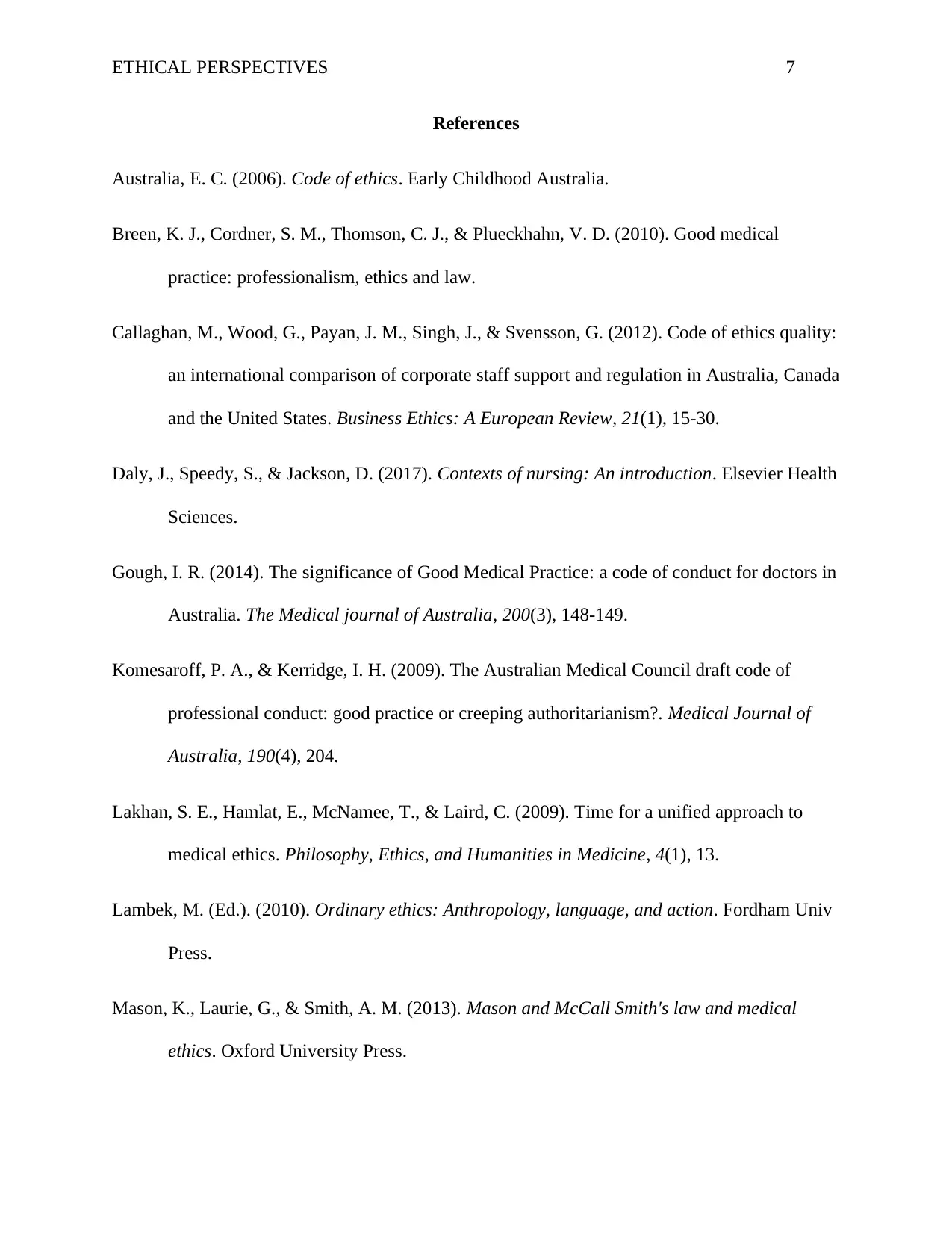
ETHICAL PERSPECTIVES 7
References
Australia, E. C. (2006). Code of ethics. Early Childhood Australia.
Breen, K. J., Cordner, S. M., Thomson, C. J., & Plueckhahn, V. D. (2010). Good medical
practice: professionalism, ethics and law.
Callaghan, M., Wood, G., Payan, J. M., Singh, J., & Svensson, G. (2012). Code of ethics quality:
an international comparison of corporate staff support and regulation in Australia, Canada
and the United States. Business Ethics: A European Review, 21(1), 15-30.
Daly, J., Speedy, S., & Jackson, D. (2017). Contexts of nursing: An introduction. Elsevier Health
Sciences.
Gough, I. R. (2014). The significance of Good Medical Practice: a code of conduct for doctors in
Australia. The Medical journal of Australia, 200(3), 148-149.
Komesaroff, P. A., & Kerridge, I. H. (2009). The Australian Medical Council draft code of
professional conduct: good practice or creeping authoritarianism?. Medical Journal of
Australia, 190(4), 204.
Lakhan, S. E., Hamlat, E., McNamee, T., & Laird, C. (2009). Time for a unified approach to
medical ethics. Philosophy, Ethics, and Humanities in Medicine, 4(1), 13.
Lambek, M. (Ed.). (2010). Ordinary ethics: Anthropology, language, and action. Fordham Univ
Press.
Mason, K., Laurie, G., & Smith, A. M. (2013). Mason and McCall Smith's law and medical
ethics. Oxford University Press.
References
Australia, E. C. (2006). Code of ethics. Early Childhood Australia.
Breen, K. J., Cordner, S. M., Thomson, C. J., & Plueckhahn, V. D. (2010). Good medical
practice: professionalism, ethics and law.
Callaghan, M., Wood, G., Payan, J. M., Singh, J., & Svensson, G. (2012). Code of ethics quality:
an international comparison of corporate staff support and regulation in Australia, Canada
and the United States. Business Ethics: A European Review, 21(1), 15-30.
Daly, J., Speedy, S., & Jackson, D. (2017). Contexts of nursing: An introduction. Elsevier Health
Sciences.
Gough, I. R. (2014). The significance of Good Medical Practice: a code of conduct for doctors in
Australia. The Medical journal of Australia, 200(3), 148-149.
Komesaroff, P. A., & Kerridge, I. H. (2009). The Australian Medical Council draft code of
professional conduct: good practice or creeping authoritarianism?. Medical Journal of
Australia, 190(4), 204.
Lakhan, S. E., Hamlat, E., McNamee, T., & Laird, C. (2009). Time for a unified approach to
medical ethics. Philosophy, Ethics, and Humanities in Medicine, 4(1), 13.
Lambek, M. (Ed.). (2010). Ordinary ethics: Anthropology, language, and action. Fordham Univ
Press.
Mason, K., Laurie, G., & Smith, A. M. (2013). Mason and McCall Smith's law and medical
ethics. Oxford University Press.
Paraphrase This Document
Need a fresh take? Get an instant paraphrase of this document with our AI Paraphraser
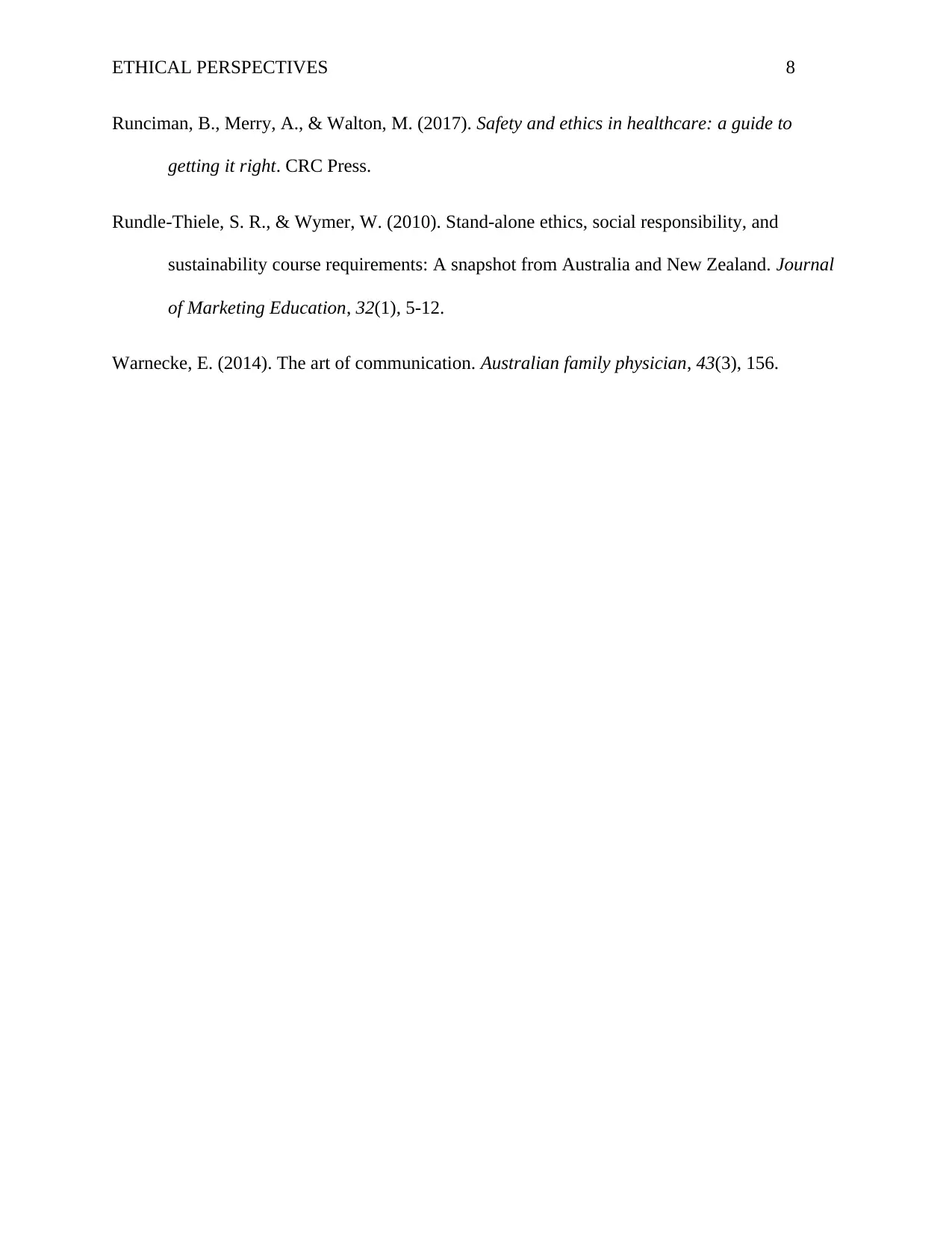
ETHICAL PERSPECTIVES 8
Runciman, B., Merry, A., & Walton, M. (2017). Safety and ethics in healthcare: a guide to
getting it right. CRC Press.
Rundle-Thiele, S. R., & Wymer, W. (2010). Stand-alone ethics, social responsibility, and
sustainability course requirements: A snapshot from Australia and New Zealand. Journal
of Marketing Education, 32(1), 5-12.
Warnecke, E. (2014). The art of communication. Australian family physician, 43(3), 156.
Runciman, B., Merry, A., & Walton, M. (2017). Safety and ethics in healthcare: a guide to
getting it right. CRC Press.
Rundle-Thiele, S. R., & Wymer, W. (2010). Stand-alone ethics, social responsibility, and
sustainability course requirements: A snapshot from Australia and New Zealand. Journal
of Marketing Education, 32(1), 5-12.
Warnecke, E. (2014). The art of communication. Australian family physician, 43(3), 156.
1 out of 8
Related Documents
Your All-in-One AI-Powered Toolkit for Academic Success.
+13062052269
info@desklib.com
Available 24*7 on WhatsApp / Email
![[object Object]](/_next/static/media/star-bottom.7253800d.svg)
Unlock your academic potential
Copyright © 2020–2025 A2Z Services. All Rights Reserved. Developed and managed by ZUCOL.





